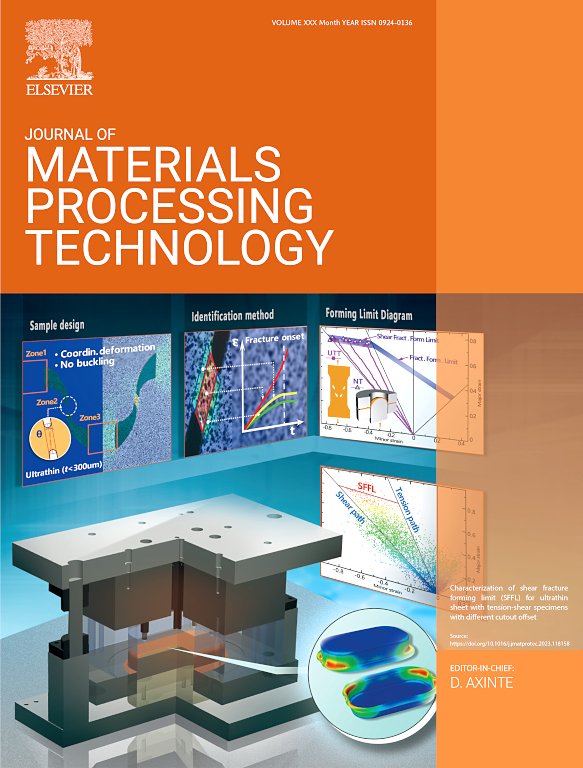增材制造结构的微结构各向异性对加工动力学的影响:以铣削 Ti6Al4V 薄壁零件为例
IF 7.5
2区 材料科学
Q1 ENGINEERING, INDUSTRIAL
Journal of Materials Processing Technology
Pub Date : 2024-10-20
DOI:10.1016/j.jmatprotec.2024.118644
引用次数: 0
摘要
薄壁结构作为航空航天部件的常见组件规格,在加工(如铣削)过程中很容易出现变形和颤振问题。随着快速成型(AM)材料越来越多地应用于这些领域,人们发现其微观结构的各向异性可导致不同方向的机械性能和可加工性。然而,以往对薄壁零件的研究主要集中在块体材料上,而对 AM 工艺生产的这些薄壁结构的加工性能仍不清楚。有鉴于此,本研究旨在以 Ti6Al4V 为例,揭示 AM 工艺产生的微观结构各向异性对薄壁零件加工(变形和稳定性)的影响。采用不同的激光扫描策略制造了三种 AM Ti6Al4V 薄壁零件,发现先期柱状 β 晶粒沿构建方向生长,并导致了机械性能的变化。因此,在同一铣削方向上,不同β相结晶取向的 AM 薄壁零件的变形和加工稳定性也不同,这可能是由于不同取向的切削力和动态参数(如频率、刚度(由弹性模量确定)、阻尼比)发生了变化。考虑到 AM 薄壁零件的微观结构各向异性,这项研究可为选择打印策略和后续加工工艺提供参考。本文章由计算机程序翻译,如有差异,请以英文原文为准。
On influence of microstructural anisotropy of additive manufactured structures upon machining dynamics: An example of milling of Ti6Al4V thin-walled parts
Thin-walled structures, as common component specification for aerospace components, easily experience deformation and chatter issues during machining (e.g. milling) operations. With Additively Manufactured (AM) materials being increasingly applied in these areas, it is found that their microstructural anisotropy can lead to varied mechanical properties and machinability in different directions. However, former research on thin-walled parts mainly focused on bulk materials, while the machining performance of these thin-wall structures produced from AM processes remains unclear. In this view, this research aims to reveal the effect of microstructural anisotropy resulting from AM process on the machining (deformation and stability) of thin-walled parts by taking Ti6Al4V as an example. Three kinds of AM Ti6Al4V thin-walled parts were fabricated with different laser scanning strategies, in which the prior columnar β grains were found to grow along the building direction and led to a variation in mechanical properties. Owing to this, the deformation and machining stability varied in the AM thin-walled parts with different β phase crystallization orientations on the same milling directions, which could be attributed to the changes of cutting force and dynamic parameters (e.g., frequency, stiffness (determined by elastic modulus), damping ratio) in different orientations. This investigation could provide a reference for the selection of printing strategies and follow-up machining process of AM thin-walled parts when considering their microstructural anisotropy.
求助全文
通过发布文献求助,成功后即可免费获取论文全文。
去求助
来源期刊

Journal of Materials Processing Technology
工程技术-材料科学:综合
CiteScore
12.60
自引率
4.80%
发文量
403
审稿时长
29 days
期刊介绍:
The Journal of Materials Processing Technology covers the processing techniques used in manufacturing components from metals and other materials. The journal aims to publish full research papers of original, significant and rigorous work and so to contribute to increased production efficiency and improved component performance.
Areas of interest to the journal include:
• Casting, forming and machining
• Additive processing and joining technologies
• The evolution of material properties under the specific conditions met in manufacturing processes
• Surface engineering when it relates specifically to a manufacturing process
• Design and behavior of equipment and tools.
 求助内容:
求助内容: 应助结果提醒方式:
应助结果提醒方式:


